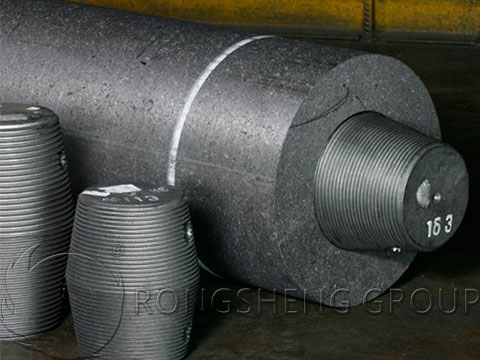Graphite electrodes for sale are used as electrical conductors and heat carriers in electric furnace steelmaking. Solitary heat is generated between the graphite electrode and the steel material to achieve the purpose of melting. There is a temperature gradient in the axial and radial direction of the graphite electrode column from the clamping end to the arc area. The change in current density in the electrode joint area, the difference in the resistance of the nipple and electrode materials, the contact resistance of the thread and the end surface, etc. form the temperature field of the joint area that is different from the electrode body. It is related to the material’s electrothermal characteristics, structural form, and connection factors. In a certain temperature field, the difference between the longitudinal and lateral thermal expansion coefficients and mechanical properties between the graphite electrode and the graphite nipple generates large heat stress in the graphite electrode nipples joint area.

Graphite Electrode Heat Stress Distribution and Discussion
When the electrode column is used, it will be subjected to external forces such as electromagnetic oscillating force and impact force caused by the collapse of the charge. The connection area also bears the effects of gravity, connection torque, and heat stress of the lower electrode. In addition to random external forces, heat stress has an important effect on the fracture, cracks, and consumption of the joint area. Here we mainly discuss the trend of heat stress caused by structural changes.
The calculation of the heat stress is based on the steady-state temperature distribution of the 4-TPI nipple long joint area. The heat stress distribution is basically similar to the 3-TPI short graphite nipple joint area. The maximum stress is the hoop tensile stress at the outer surface of the electrode end, followed by the axial tensile stress of the thread root, the axial tensile stress on the outer surface of the electrode hole bottom, and the radial stress is smaller. According to the strength theory calculation, the maximum heat stress is obtained at the bottom corner of the electrode hole.
Compared with the 3-TPI short graphite nipple, the change characteristics of the heat stress of the 4-TPI nipple are:
- The surface hoop tensile stress value and area of the UHP electrode end face are reduced (about 30%);
- The axial tensile stress of the thread root is slightly increased, and the maximum value is the 4-TPI nipple root from the large diameter of the graphite electrode nipple;
- The axial tensile stress on the outer surface of the bottom of the electrode hole increased slightly.
It can be concluded from this that the 4-TPI long nipple connection structure has structural characteristics and is beneficial to improve the temperature distribution. Heat Stress in the Graphite Electrode Nipples. This improves the heat stress in the joint area and is an optimized structure. The choice of graphite electrode nipple length can be further explored from the perspective of usability and economy.

